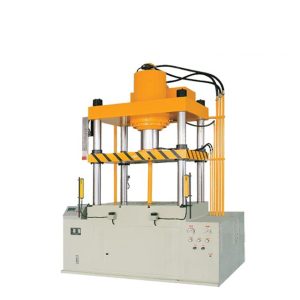Today’s blog is about the classification of hydraulic press, let’s take a look!
A simple classification of hydraulic press
A hydraulic machine is a kind of machine that also uses hydraulic oil as the power source. Through the force of the hydraulic pump, the hydraulic oil is circulated in the oil tank by the check valve to make the oil cylinder/piston circulate to do work, so as to complete certain mechanical actions as a kind of productivity.
According to the fuselage structure of the hydraulic press, common are four-column hydraulic press (er beam, three-beam, four-beam, five-beam), frame hydraulic press, gantry hydraulic press, single-column hydraulic press, horizontal hydraulic press, etc.
Hydraulic presses with different structures and tonnages are selected for different products, and the same hydraulic press can also change molds to complete the processing of different styles of products. Hydraulic presses are widely used in aerospace, nuclear power, petrochemical, auto parts, bicycle parts, hardware products, instruments, medical equipment, household appliances, household utensils, sanitary kitchen utensils, and other manufacturing industries.

According to different applications, the hydraulic press can be classified into the following types:
1. Manual hydraulic press: It is used to complete simple work with low pressure and manual operation.
2. Forging hydraulic press: used for free forging, billeting of steel ingots and die forging of non-ferrous and ferrous metals.
3. Stamping hydraulic press: used for stamping and stretching of various thin and thick plates, including single-acting, double-acting, and rubber die stamping.
4. General-purpose hydraulic presses: including all kinds of universal general-purpose hydraulic presses.
5. Hydraulic press for calibration and press-fitting: used for parts calibration and assembly.
6. Laminating hydraulic press: used for pressing plywood, particle board, fiberboard, and insulating material board.
7. Extrusion hydraulic press: It is used to extrude various non-ferrous metals and ferrous metals, such as wires, pipes, bars, profiles, and workpieces for deep drawing and perforation.
8. Pressing hydraulic press: used for pressing and forming various powder products, such as powder metallurgy, artificial diamond, refractory brick, carbon pole, plastic, rubber products, etc.
9. Packing and briquetting hydraulic press: used for briquetting and packing metal chips and scraps, packing non-metallic scraps, etc.
10. Other hydraulic presses: used for punching, drawing, press-fitting of axles, etc.

But if you classify the hydraulic press with its structure, the consequence is totally different.
Features of hydraulic presses with different structures:
1. Four-column hydraulic press:
Four-column hydraulic presses are used in precision tooling applications. Four-post four-beam hydraulic presses, four-post three-beam hydraulic presses, and four-post two-beam hydraulic presses are the different categories available recently. These presses are highly recommended for applications where pressure is the primary concern. A four-column press will provide equal pressure distribution. The advantages of the four-column hydraulic press are flexibility, versatility, smooth transition, easy operation, fast installation and maintenance, and low cost.
2. Single-column hydraulic press:
Single-row hydraulic presses are also known as C-frame hydraulic presses. Because the main body of this press is a C-shaped single-arm structure. The advantages of single-column hydraulic presses are excellent rigidity, guiding performance, speed, and high precision. The automotive, electronics, home, and medical industries use C-frame hydraulic presses for sheet metal forming, plastic forming, bending, deep drawing, and other applications. The C-frame press is convenient for small and medium-sized equipment to take up space due to its small size.
3. Horizontal hydraulic press:
Rail straightening and contouring, plate straightening, punching, structure straightening and contouring, punching, etc. are important applications of horizontal hydraulic presses. It is a multifunctional machine whose parts can be assembled, disassembled, straightened, compressed, stamped, etc. A standard horizontal hydraulic press will include a unique hydraulic system to prevent overloading the machine. The press can be connected with different tools. The hydraulic press’s heavy-duty cast iron valve body provides long service life. The height of the workbench can be arranged according to the comfort of the workers.
4. Gantry hydraulic press:
According to the type of fluid used to transmit power, the gantry full-steel structure is adopted, and the mechanical deformation is small after vibration aging treatment. The frame design is designed by finite elements, with high rigidity and high precision. The workbench of the gantry hydraulic press can move up and down, which greatly expands the opening and closing height of the machine and makes it more convenient to use.
5. Frame-type hydraulic press
The fuselage has two types: integral type and combined type. It adopts a four-corner and eight-sided guide rail design, which has the advantages of high precision and strong anti-eccentric load capacity. Most of the sliders are guided by 45° inclined guide rails, and the guiding accuracy is high. Therefore, it is widely used in the design of hydraulic presses such as plastic products, powder metallurgy, double-action thin plate stamping, and metal extrusion.

Now, the types of hydraulic press and their different functions are clear.
People can choose a machine according to their own requirements. Do you need one?



